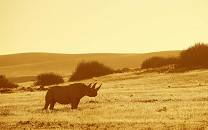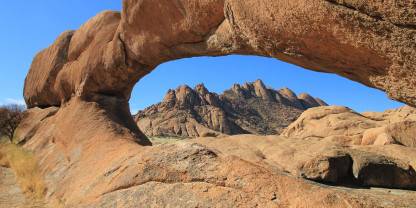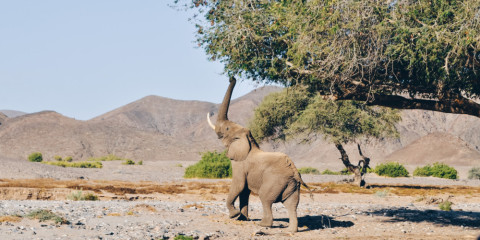The huge wilderness of Damaraland is one of Africa’s last remaining unofficial wildlife areas. It is thinly populated with both people and animals. The main reason to visit is the stunning desert environment, and spotting wildlife can be a question of luck. That said, even the possibility of seeing some real desert specials – including desert-adapted elephant, black rhino and lion – brings a certain magic to this special place. The region also has several important rock-art sites.

-
Best Time To Go
- May to October (Animals are easier to see)
-
High Season
- July to November (Some places can get quite busy)
-
Size
- 47,990km² / 18,529mi²
-
Altitude
-
1,300-2,573m /4,265-8,442ft
 View Photos
View Photos
 View Photos
+24
Photos
View Photos
+24
Photos
 Open Map
Open Map
Pros & Cons
- Great wilderness experience
- Stunning desert scenery
- A chance to see rare desert elephants, lions and black rhinos
- Numerous accommodations options catering to different budgets
- Low densities and variety of wildlife
- Remote destination with varying unsealed road conditions
- Very hot climate
Wildlife
Northern Damaraland is one of the only places in Africa to see desert elephant, and even desert-adapted lion. Black rhino also fare well in a desert environment, and the Save the Rhino Trust has set up a program to track these hard-to-find creatures. Other animals that can be encountered are giraffe, Hartmann’s mountain zebra, gemsbok, greater kudu, eland and springbok. Leopard and cheetah are present but seldom seen.
More about Damaraland’s wildlifeScenery
Damaraland has some of the most spectacular desert landscapes in Africa. Wild desert mountains with jagged peaks and barren slopes rise from the Skeleton Coast. Elsewhere, deep ravines, cliffs and outcrops create a perfect environment for well-preserved ancient rock art. The Spitzkoppe, a remnant of an ancient volcano, is one of Namibia’s most recognizable landmarks and a popular climbing destination.
Activities
Although there are a number of community concessions or conservancies, which may have their own rules, there are no national parks in Damaraland. This means that both guided and self-guided are possible, as well as night drives and . Another highlight is the chance to go rhino tracking, an activity that is offered by some lodges and camps.
Weather & Climate
Damaraland’s climate can vary from very hot daytime temperatures in summer, which is the Wet season (November to April), to very cold nighttime temperatures in winter, which is the Dry season (May to October). This is mainly due to significant changes in altitude across the region, with temperatures falling as you clamber up the coastal mountains. Generally, winter is very dry, while summer has only occasional rainfall.
More about the weather and climateBest Time To Visit
The Dry season (May to October) offers the best weather and the highest chance of seeing wildlife. During this time, animals stay close to the few remaining water sources, making wildlife viewing at local most rewarding. If you’re more into landscapes, you might appreciate the greener environment and dust-free skies of the Wet season (November to April).
More about the best time to visit



